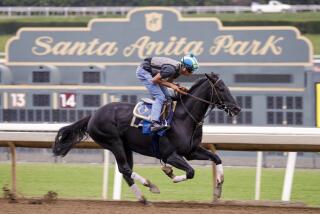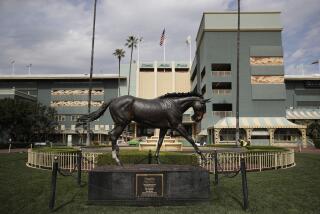Rise of horse deaths at Santa Anita to be investigated by district attorney

Twenty-two horses have died at Santa Anita Park since Dec. 26. Experts are trying to figure out why.
As Santa Anita watched its reopen date slip away because of its proposed new medication regulations, the Los Angeles district attorney’s office assigned investigators to look into the deaths of 22 horses since Dec. 26.
But the day wasn’t all bad, as the track found some support from its trainers over a new set of regulations except in the area of race-day Lasix, which is the topic holding up the reopening. And there were no reported incidents of any injuries as 96 horses worked out over both the main dirt and training tracks Friday.
Santa Anita was originally scheduled to reopen March 22, but because of its plan to impose a restriction of no race-day Lasix, it has to first be approved by the Thoroughbred Owners of California and then by the California Horse Racing Board. Any agreement with the CHRB can come only after a 10-day public notice, according to Rick Baedeker, executive director of the CHRB. There is also no agreement with the TOC.
So, for now, Santa Anita’s regulatory changes are on hold until it meets all the state regulatory rules for notification. Plus, it has to come to an agreement with the TOC. In short, no racing next weekend unless Santa Anita reverses its position on race-day Lasix.
Meanwhile, the district attorney’s office confirmed Friday that it would work with the CHRB to find out what may have caused all the equine deaths.
On Thursday, Princess Lili B, a 3-year-old filly, was the latest casualty as she broke both front ankles at the end of a half-mile workout on the main dirt track. She was later euthanized. It was the 10th death in dirt training, adding to seven during dirt racing and five during turf racing.
On March 1, PETA requested that an investigation be conducted into the horse deaths as violations of the California cruelty-to-animal laws. In the three-page letter to Jackie Lacey, L.A. district attorney, the animal-rights advocacy group cited historical data but nothing specific about the current deaths of horses.
“We’re happy to have them involved,” Baedeker said. “We can explain our current process and get them the information they’re looking for. They were happy to learn we have sworn officers, some of who used to work for the district attorney. We’ll get them what they need, as I’m sure anyone else in the industry will do.”
In a news release, PETA said an investigation should look at trainers and veterinarians.
“We welcome an investigation,” said Alan Balch, executive director of the California Thoroughbred Trainers. “It’s long past the time that these unfounded accusations be proven wrong and that everyone realize that our trainers’ first concern is always for their horses.”
Judy Chu, who serves in the House of Representatives for the area of the San Gabriel Valley that includes Arcadia, also called for an investigation.
She said the House Energy and Commerce Committee should “investigate and hold a hearing on the treatment of horses at Santa Anita and throughout our country. … Until we know the horses are safe, the Santa Anita [race track] should be closed.”
On Thursday, the Stronach Group announced a series of measures it says will make racing safer at its two California tracks. But instead of bringing an immediate sense of calm to an industry feeling it’s on the precipice, it was met with skepticism as everyone tried to figure out the ramifications of the changes.
The new measures include a controversial race-day ban on Lasix, a diuretic used to ease breathing and lessen the chances of bleeding from the lungs. Almost every country outside the U.S. bans its use on race day. According to the Jockey Club, only 3.6% of the almost 300,000 starts last year in the U.S. were made without Lasix.
Dr. Rick Arthur, who is the chief veterinarian of the CHRB, said there “is virtually no relationship whatsoever” between Lasix and catastrophic musculoskeletal injuries (CMI), the almost universal cause of breakdowns on the track. However, the Stronach Group plan comes with other medication rules that Arthur is encouraged about, including increasing the regulations on legal non-
“I have no objection to what the Stronach Group is doing,” Arthur said. “I think horse racing has to position itself in the future.”
This view on regulations is shared by the trainers.
“Many of these rules are highly regulated, and we would be open to an even higher standard.’’ Balch said. “We also support significantly increasing out-of-competition testing and the digitizing of detailed veterinarian records in perpetuity.’’
The Thoroughbred Owners of California plans a member call Saturday to discuss these latest changes. In a note to membership, it cited “potential unforeseen consequences of the implementation of the announced reforms.” A message to Greg Avioli, president and chief executive of the TOC, was not returned.
Those consequences likely include potentially losing horsemen to other states with fewer restrictions on medication.
Trainer Peter Miller said the vast majority of trainers are against banning Lasix and insisted there was no connection between a horse’s soundness and use of the drug designed to protect against bleeding.
“My owners are of the mind-set to leave the state if there’s no Lasix, and so am I,” he said. “I find it inhumane. You wouldn’t have someone with high cholesterol and high blood pressure problems and not give them medication.”
Trainer John Sadler also expressed concern over the new rules.
“This stuff is so new, I don’t know how it will be implemented or when,” Sadler said. “[Management] has to have some serious discussions on their side. They’ve carded 13 races for the Santa Anita Derby [on April 6]. You have to cut back the number of races and race dates, all those things. … This kind of make it up as you go along doesn’t make sense.”
One rule that seems to already have been implemented is forbidding the use of a riding crop to urge horses unless it’s required for safety.
The entrance to the stretch now has a sign, in both English and Spanish, that says “USE OF CROPS FOR SAFETY PURPOSES ONLY. NO STRIKING ALLOWED.”
When the Stronach Group announced its changes, it implied that Del Mar was completely on board, but that wasn’t the case.
“We certainly support what they are trying to do, and we think it’s the right step for them and the industry,” said Joe Harper, the CEO at Del Mar. “But I think we’ve got a lot of work to do with the horsemen. Lasix has always been the stumbling block.”
Harper later told Thoroughbred Daily News that Lasix will be allowed at the two Del Mar meetings this year. Los Alamitos also announced that it plans to allow the use of Lasix for both thoroughbreds and quarter horses.
While all of this plays out, there remains one factor that overshadows all others. Santa Anita has to have clean training from now until racing resumes and then continue with incident-free racing. Its survival might depend on it.
Sign up for our horse racing newsletter »
More to Read
Get our high school sports newsletter
Prep Rally is devoted to the SoCal high school sports experience, bringing you scores, stories and a behind-the-scenes look at what makes prep sports so popular.
You may occasionally receive promotional content from the Los Angeles Times.









